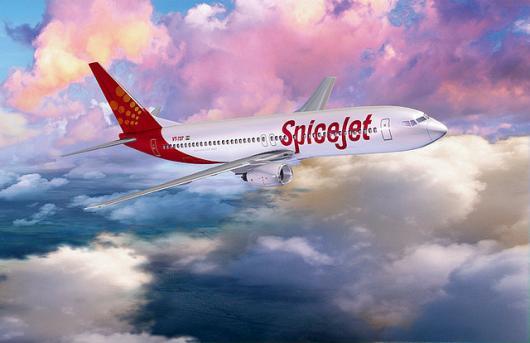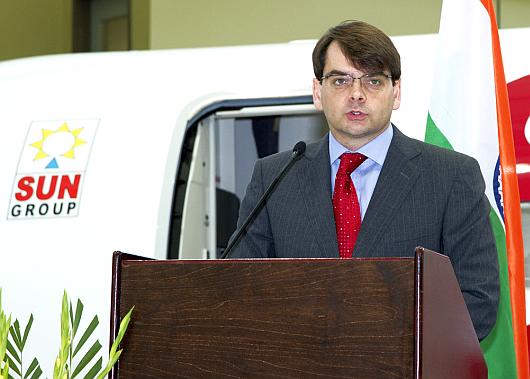Photographs: Courtesy, SpiceJet Surajeet Das Gupta in New Delhi
SpiceJet has every reason to rejoice. Its strategy of funnelling traffic from smaller cities ignored by other airlines to regional hubs and flying to uncharted routes abroad like Kabul, Guangzhou and Male is reaping rich rewards.
The airline, now owned by Kalanithi Maran, posted net profit of Rs 102 crore (Rs 1.02 billion) for the quarter ended December 2012.
In the same quarter of the previous year, it had reported a loss of Rs 39 crore (Rs 390 million). Its yield per passenger has risen around Rs 1,000, or 29 per cent, in last one year.
To put it in perspective: the airline had posted a loss of Rs 600 crore (Rs 6 billion) in 2011-12 on the 12 million tickets it had sold; that translates to a loss of Rs 500 on each ticket.
In spite of the handsome profits in the last quarter, SpiceJet's problems are far from over. In the first nine months of 2013-14, it is still in the red: its loss stood at Rs 5.36 crore (Rs 53.6 million). That it needs to wipe out in the current quarter.
But it happens to be the lean season, when leisure travel takes the backseat. The airline's performance has wavered from a bountiful first quarter (profit of Rs 56 crore or Rs 560 billion) to a disastrous second quarter (loss of Rs 163 crore or Rs 1.63 billion), and now a brilliant third quarter.
...
How SpiceJet plans to reverse its fortune
Photographs: Jayanta Dey/Reuters
Slim pickings
With February and March traditionally being the lean season, when people fly much less, the airline is relying on heavy discounts to spur sales.
A few days ago, it had put up for sale one million tickets on a heavily-discounted price of Rs 2,013 (all inclusive) apiece. The window was kept open for 72 hours.
Though buyers complained the site crashed frequently, thanks to the heavy traffic, SpiceJet managed to sell 70 per cent of the inventory.
However, analysts are not sure whether the company's gamble to sell tickets at rock-bottom fares will help it make up for the shortfall of the previous quarters and end the year in the black.
Its past record has been less than inspiring. It had made a hefty loss of Rs 249 crore (Rs 2.489 billion) in the last quarter of 2011-12.
Says a top executive of a competing domestic carrier: "SpiceJet's yields, like most other low-cost carriers, are still under pressure despite the improvement because full-service carriers have dropped fares to similar levels, even though their costs are much higher. And, now most of them like Jet and Air India are also dropping fares through promotion packages in the lean season."
...
How SpiceJet plans to reverse its fortune
Image: Spicejet CEO Neil Mills.Photographs: Courtesy, Bombardier Aerospace
But Neil Mills, Spicejet's unassuming CEO, already has a strategy in place for the next 12 to 24 months which, if he is able to pull through, would earn him the reputation of a turnaround artist in the aviation industry.
Says Mills: "Our plan is to increase our revenue share from international operations, expand our regional routes, and improve PLF (passenger load factor) and revenue in the lean season by our limited three-day offer"
His immediate challenge is, of course, to increase revenue from each aircraft and arrest the fall in PLF which happens during the lean season. He has partly bridged the problem by the discount offer.
That constitutes for over 20 per cent of his total inventory for the three lean months of March, April and May. (The predatory pricing has left the civil aviation ministry worried about the consequences for other airlines. A price war, it fears, could make the sector bleed once again. Airfares had risen steadily after Kingfisher Airline's exit, benefiting all airlines.)
"We sold 700,000 tickets. My total cost for the flights has not gone up, yet my total revenue from the flights has gone up. PLF in these months falls to 70-75 per cent (compared to 75-80 per cent in peak seasons); this will help us in increasing it a few percentage points," says Mills.
...
How SpiceJet plans to reverse its fortune
Image: Air Asia regularly puts up discounted and free tickets across its network in mega sales.Photographs: Bazuki Muhammad/Reuters
Spreading wings
Mills doesn't agree that SpiceJet's idea was to trigger a price war. Those who booked tickets in the recent offer, he says, were first-time travellers who had no plans to fly, but got drawn in by the low fare, and that he was not really out to grab business from competitors.
Travel portals agree that it did not majorly impact the business of competing airlines except a low-cost carrier in Andhra Pradesh, which saw its sales fall dramatically during the three days when the discounts were on offer.
Of course, Mills is not doing anything which is not known globally, but by doing it aggressively he has shaken up the market.
He has virtually taken a leaf from his earlier stint in the low-cost carrier, Easy Jet, and from other global players who offer discounted fares.
US-based JetBlue, for instance, offers low fares for bargain hunters on Tuesdays, which are known as "Cheeps", are meant for last-minute travel and are promoted on Twitter (which has almost no costs).
European low-cost airline Ryanair holds a winter sale offering seats starting from 8 pounds onwards for travel between Monday and Thursday in January.
And nearer home, Air Asia regularly puts up discounted and free tickets across its network in mega sales. In its latest sale, the airline offered 800,000 seats at discounted price.
...
How SpiceJet plans to reverse its fortune
Image: SpiceJet's Board member Kavery Kalanithi on the left, chairman Kalanithi Maran behind her, CEO Neil Mills in the middle and COO Sivasubramanian Natrajhen on the right.Photographs: Courtesy, Bombardier Aerospace
However, Mills' bigger mid-term plan is to move more and more capacity to international routes. Mills says that currently only 7 per cent of his revenue comes from the international operation; this will rise to 20 per cent in the next 18-24 months.
He also says that the new planes (six or seven of them) which would join the fleet in the days to come will all be deployed on international routes.
He has already received permission to add more uncharted routes like Al Najaf in Iraq, Macau and Ho Chi Minh City.
International routes appear more attractive to airlines. The fuel cost on international routes is at least 20 per cent cheaper than on domestic routes, so airlines make better margins.
Fuel accounts for nearly 45 per cent of the operating cost of an airline and any savings on this account goes directly to the bottom-line.
Already, with its limited international operations, Mills says he has been able to reduce the cost of fuel (as a proportion of revenue) by 5 per cent this quarter.
But Mills could soon lose his first-mover advantage in the international skies. Competing airlines are also realising the potential to fly to uncharted international destinations where one can charge higher fares.
So Air India has also got permission to fly to Al Najaf and Jet Airways to Ho Chi Minh City. They will soon be jostling for space in these virgin markets too, but that is a challenge, which a growing airline will always have to face.
(Disha Kanwar and Aneesh Phadnis contributed to this report)







article